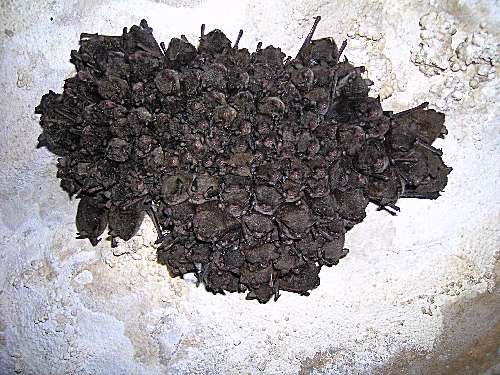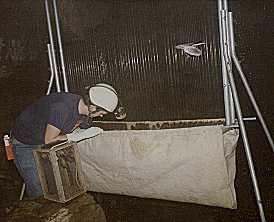Indiana bat (Myotis sodalis)
 The insectivorous Indiana bat bears a strong resemblance to the more- common Little Brown bat (Myotis lucifugus) and wasn't initially recognized as a separate species. Although only slightly different in color, Indiana bats are easily identified by their tendency to form compact groups on horizontal cave ceilings (sodalis = social). A typical cluster, shown at right, contains about 300 bats per square foot.
The insectivorous Indiana bat bears a strong resemblance to the more- common Little Brown bat (Myotis lucifugus) and wasn't initially recognized as a separate species. Although only slightly different in color, Indiana bats are easily identified by their tendency to form compact groups on horizontal cave ceilings (sodalis = social). A typical cluster, shown at right, contains about 300 bats per square foot.
Due largely to this behavior, Indiana bats are very susceptible to flooding or other disturbances during hibernation. Repeated awakenings may cause significant depletion of the stored fat that is necessary to survive. Below, an IKC researcher is using a harp net to collect bats at a Greene County cave to measure how much weight was lost over the winter.
 In October, Indiana bats swarm at their hibernation sites; this activity accompanies mating. Fertilization does not occur until the female leaves the site the following March. In summer, males and females live apart from each other, with the females forming nursery colonies in hollow trees or under bark. A single pup is born in late June and the young become independent from their mothers in 4-5 weeks.
In October, Indiana bats swarm at their hibernation sites; this activity accompanies mating. Fertilization does not occur until the female leaves the site the following March. In summer, males and females live apart from each other, with the females forming nursery colonies in hollow trees or under bark. A single pup is born in late June and the young become independent from their mothers in 4-5 weeks.
Indiana bats prefer colder hibernating conditions than most Indiana caves offer. The IKC manages two significant Indiana bat hibernacula in Monroe County. Members participate in a biennial census of the bats in Indiana caves, and have installed temperature monitors and prototype surveillance devices in the largest hibernacula. Although listed as endangered throughout its range, census figures indicate that populations in Indiana are steady or slightly increasing.
Harp net photo courtesy S Johnson / Indiana Dept of Natural Resources

